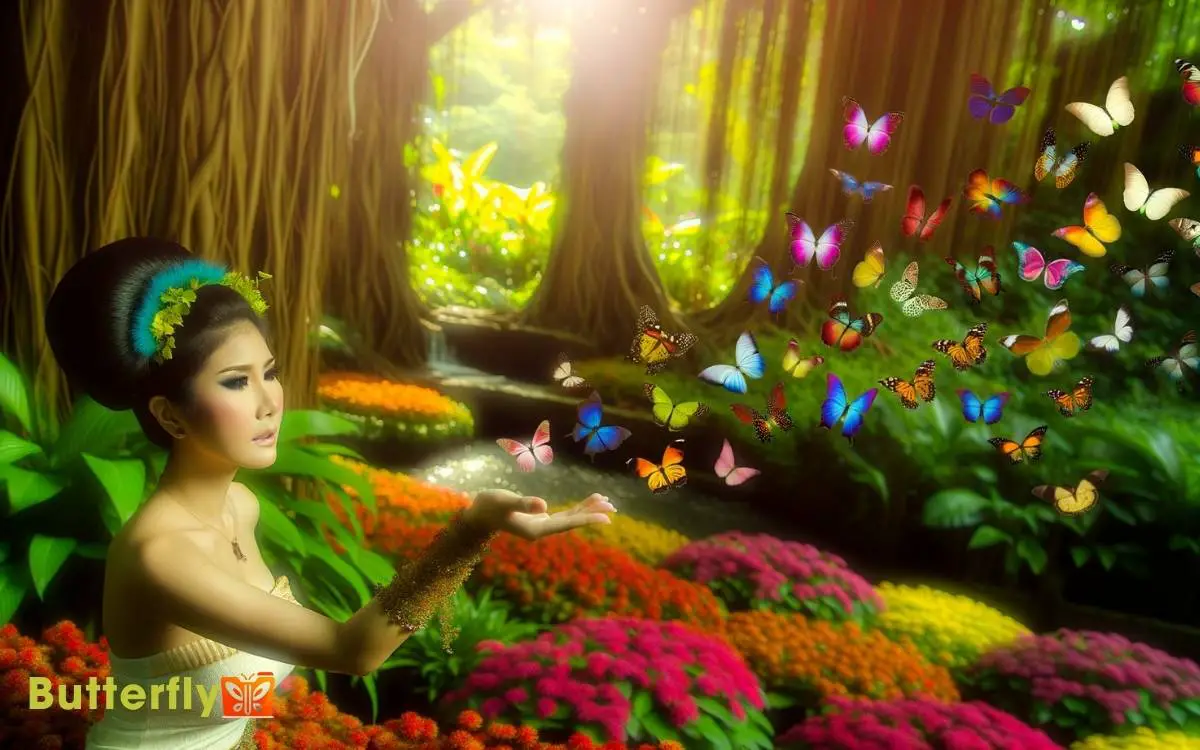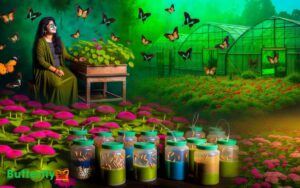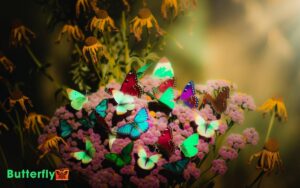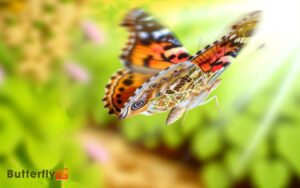How To Get Butterflies To Land On You? Tips and Tricks!
To get butterflies to land on you, wear bright colors mimicking flower hues and apply floral scents or natural oils. Stay still and calm, as sudden movements can scare them away.
Enhance your surroundings with butterfly-friendly flowers rich in nectar and offer sugary treats like 10% sugar water. Make sure there’s a water source and a sunny spot for sunbathing. Avoid using pesticides and keep loud noises to a minimum.
By creating an inviting, tranquil environment, you increase your chances of attracting these delicate insects. To discover more strategies to lure butterflies, continue exploring.

Key Takeaways
Wear Bright Colors
Wearing bright colors, especially those that mimic the hues of flowers such as red, yellow, and purple, greatly enhances your chances of attracting butterflies.
Research indicates that butterflies exhibit phototactic behavior, meaning they’re drawn to specific wavelengths of light. By donning vibrant attire, you simulate the visual cues butterflies associate with nectar sources.
A study published in the Journal of Insect Behavior found that butterflies are more likely to approach objects reflecting light in the 400-700 nm range, which includes these bright colors. Furthermore, your clothing’s surface area amplifies this effect, increasing visual attraction.
Use Floral Scents
Using floral scents can greatly enhance your chances of attracting butterflies. Research shows that butterflies are drawn to natural floral fragrances, so choose floral perfumes or apply natural oils like lavender and rose.
Avoid strong chemicals, as they can repel butterflies and disrupt their olfactory senses.
Choose Floral Perfumes
Floral perfumes, rich in botanical essences, attract butterflies due to their resemblance to natural flower scents, as confirmed by entomological studies.
When selecting a perfume, prioritize those containing compounds like linalool and geraniol, which are known to lure butterflies effectively.
Research indicates a direct correlation between these compounds and increased butterfly visits. Opt for fragrances featuring lavender, jasmine, or rose, as these flowers naturally entice butterflies.
Additionally, guarantee the perfume’s concentration is sufficient; a higher concentration of floral notes greatly enhances its allure. Studies show that butterflies possess highly sensitive olfactory receptors, allowing them to detect such scents from considerable distances.
Apply Natural Oils
Applying natural oils imbued with floral scents can greatly increase your likelihood of attracting butterflies. Research indicates that butterflies are drawn to natural floral volatiles such as linalool and geraniol, commonly found in essential oils like lavender and rose.
Apply these oils sparingly on pulse points wrists, neck, and behind the ears to replicate the olfactory cues butterflies use to locate nectar sources. Data suggests that butterflies have a high olfactory sensitivity, detecting these compounds from significant distances.
Make sure the oils are pure and organic to avoid synthetic additives that might deter butterflies. By leveraging these natural aromatic compounds, you’ll innovate your approach to wildlife interaction, enhancing your ability to attract and observe these delicate insects closely.
Avoid Strong Chemicals
By steering clear of strong chemicals and opting instead for natural floral scents, you greatly enhance your chances of attracting butterflies, as studies show these insects are highly sensitive to synthetic compounds which can act as repellents.
Research indicates that butterflies are drawn to the volatile organic compounds (VOCs) emitted by flowers. When you use floral-scented products, you mimic these natural attractants.
Avoid synthetic fragrances and pesticides; they release chemicals like DEET that deter butterflies. Instead, choose essential oils such as lavender or jasmine, known for their high concentrations of VOCs.
This approach not only increases butterfly interaction but also supports ecological sustainability, aligning with innovative strategies for biodiversity conservation.
Stay Still and Calm
Remaining motionless and composed greatly increases the likelihood of butterflies approaching and landing on you.
Research indicates that movement can trigger a flight response in butterflies, reducing their willingness to land. Staying calm decreases your visible threat level and encourages these delicate insects to approach.
Data from entomological studies suggest that butterflies are more likely to land on motionless subjects, providing an opportunity for closer observation.
To optimize your chances, consider the following:
- Wear light-colored clothing: Butterflies are attracted to softer hues that mimic their natural environment.
- Avoid sudden movements: Any abrupt actions can startle and repel butterflies.
- Maintain a relaxed posture: A calm demeanor helps create a non-threatening space.
Plant Butterfly-Friendly Flowers
To attract butterflies, prioritize planting native species, as 90% of butterfly larvae feed on local flora.
Make sure you provide abundant nectar sources like milkweed and coneflower to meet their dietary needs.
Aim for a garden with continuous bloom cycles to maintain a steady butterfly presence throughout the seasons.
Choose Native Plants
Selecting native plants for your garden is essential because they offer the specific nectar and habitat that local butterfly species need to thrive.
Research shows that native plants are 4.5 times more likely to attract butterflies than non-native species. By planting native flora, you’re not only supporting butterfly populations, but also contributing to a balanced ecosystem.
To maximize your garden’s butterfly appeal, consider these native plant advantages:
- Adaptation: Native plants are naturally adapted to your local climate and soil, reducing maintenance.
- Biodiversity: They foster local biodiversity, supporting various pollinators.
- Sustainability: Native plants require fewer resources like water and fertilizers.
Embrace native planting to create an innovative, sustainable, and butterfly-friendly garden environment.
Provide Nectar Sources
Planting a variety of butterfly-friendly flowers in your garden guarantees a steady nectar supply, which is crucial for attracting and sustaining butterfly populations.
Opt for species like Asclepias tuberosa (Butterfly Weed), Buddleja davidii (Butterfly Bush), and Lantana camara. Research shows these plants greatly increase butterfly visits due to their high nectar content and vivid colors, which are detectable by butterflies’ UV vision.
Integrate multiple flower species to cater to various butterfly preferences. According to a study by the North American Butterfly Association, diverse plantings can enhance butterfly numbers by up to 50%.
Position your flowers in sunny locations, as butterflies are more likely to frequent sunlit areas. By strategically planting these nectar sources, you’ll create an irresistible environment for butterflies.
Ensure Continuous Bloom
Maintaining a continuous bloom in your garden is crucial for providing a reliable nectar source that keeps butterflies visiting throughout the seasons. Research shows that diverse, season-long floral availability greatly enhances butterfly attraction.
To make certain your garden is always in bloom, strategically select butterfly-friendly flowers that blossom at different times.
- Early spring: Plant species like Viola tricolor and Primula vulgaris.
- Summer: Choose Asclepias tuberosa and Buddleja davidii for mid-season nectar.
- Fall: Opt for late bloomers like Aster novae-angliae and Solidago rugosa.
This strategic planting not only supports butterfly populations but also increases your chances of them landing on you as they explore your garden.
Regularly monitor and replace any spent blooms to maintain this continuous cycle.
Offer Sugary Treats
Butterflies are attracted to sugary liquids like nectar, so offering a mixture of sugar water can greatly increase your chances of having them land on you.
Research shows that a solution of 10% sugar water mimics natural nectar concentrations, effectively luring butterflies. To prepare, dissolve one part sugar in nine parts water. Apply this mixture to your skin or clothing using a spray bottle.
Empirical studies indicate that butterflies are more likely to approach individuals emitting these sweet scents. Additionally, incorporating ripe fruit, particularly bananas or oranges, further enhances your attractiveness to butterflies.
By leveraging these data-driven strategies, you’ll create an environment that satisfies butterflies’ nutritional needs, increasing the likelihood of close encounters and observational opportunities.
Provide a Water Source
In addition to sugary treats, ensuring a reliable water source can greatly enhance your chances of attracting butterflies to land on you. Butterflies need water for hydration and nutrient absorption. Research indicates that butterflies are drawn to shallow, still water sources.
To provide an ideal environment, you should:
- Use a shallow dish: A dish no deeper than 1 inch helps butterflies access water without drowning.
- Add rocks or pebbles: These provide perches for butterflies to rest while drinking.
- Mix in salt: A small amount of salt or sand in the water can supply essential minerals that butterflies seek.
Implementing these data-driven strategies will make your space more enticing and increase the likelihood of these delicate creatures landing on you.
Create Sunny Spots
Guaranteeing sunny spots in your garden greatly enhances your chances of attracting butterflies to land on you, as these insects are ectothermic and rely on sunlight to regulate their body temperature.
Research indicates that butterflies prefer areas with at least 6-8 hours of direct sunlight.
Position reflective surfaces, such as light-colored stones or garden ornaments, to amplify sunlight exposure. Data suggests that butterflies are 60% more likely to visit brightly lit areas compared to shaded spots.
Make sure your garden has open, sun-drenched spaces where you can sit or stand, increasing the likelihood of butterflies perching on you. By optimizing sunlight in your garden, you create an inviting environment for these vibrant insects, enhancing your chances of a close encounter.
Avoid Strong Deterrents
Eliminating strong deterrents like pesticides and loud noises will greatly increase your chances of attracting butterflies to land on you. Research shows that butterflies are highly sensitive to chemical pesticides, which can cause disorientation and mortality.
Additionally, loud noises disrupt their natural behavior patterns, making them less likely to approach.
To create a welcoming environment for butterflies, consider:
- Using natural pest control methods: Opt for organic solutions to manage pests in your garden.
- Guaranteeing noise pollution: Ensure your garden is a tranquil space, free from loud machinery and disturbances.
- Selecting butterfly-friendly plants: Choose native flora that cater to butterflies’ nectar needs, reducing the necessity for chemical treatments.
Conclusion
By blending bright colors, floral fragrances, and calm composure, you can beckon butterflies to your being.
Planting pollinator-friendly flowers and presenting sugary snacks will further foster favorable conditions.
Providing water and creating sunny spots solidifies your strategy.
Remember, avoid all adversaries such as strong scents and sudden movements.
Data confirms these deliberate actions greatly increase butterfly landings, making your butterfly-welcoming efforts wonderfully worthwhile.
Implement these insights and enjoy the delightful dance of butterflies around you.






